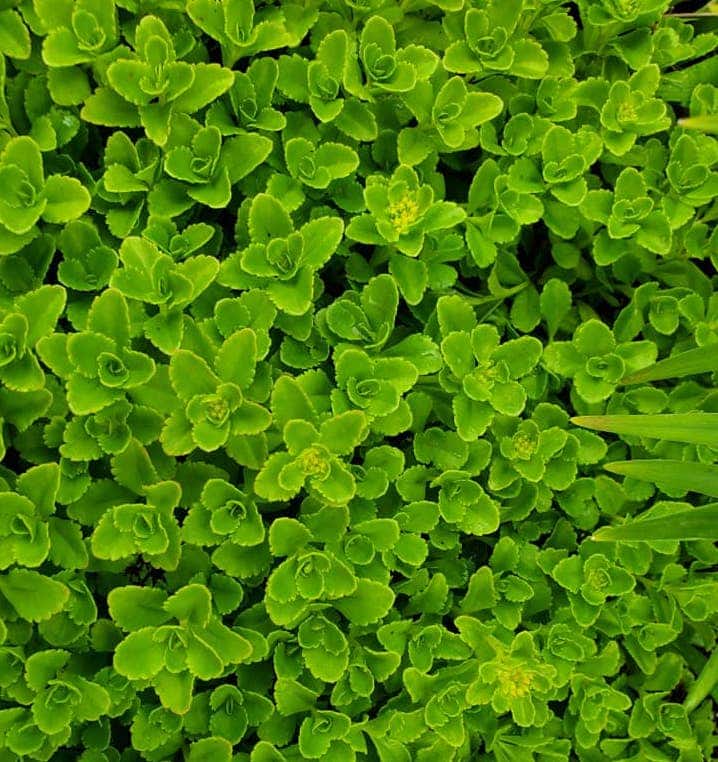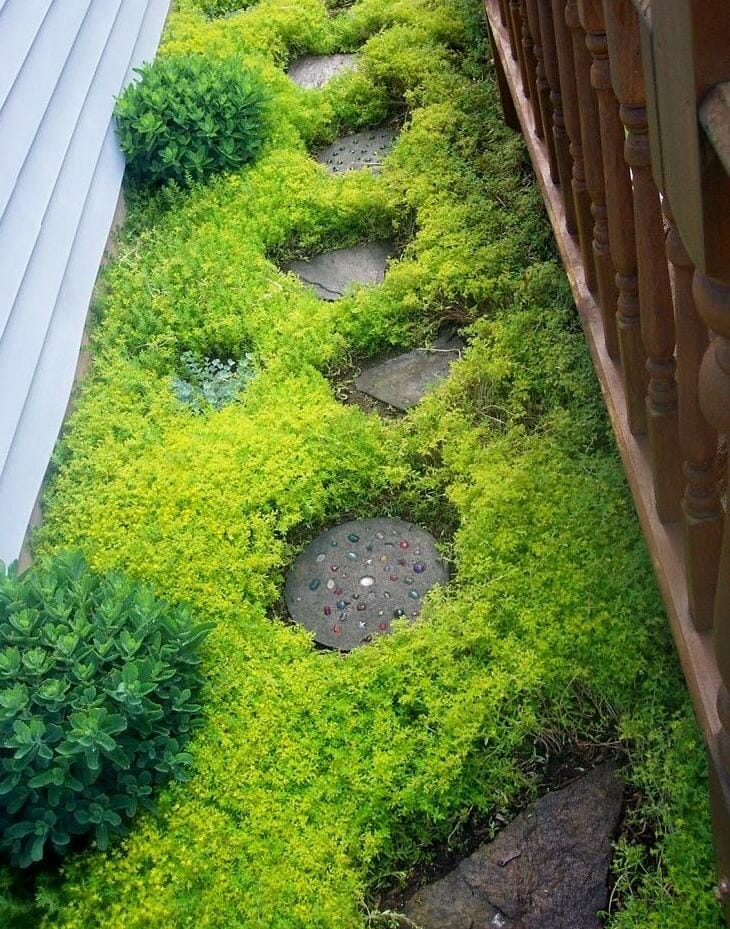There are plenty of reasons for shifting from traditional grass to alternative ground cover, including minimizing lawn work and adding color to your lawn.
You have multiple excellent options for grass alternatives, including Sedum.
Sedum is a great choice for people looking for a colorful, low-maintenance lawn, especially in dry areas. This plant flourishes even in locations with poor soils.
While these wonderful succulents don’t need much maintenance, you’ll have to baby them a bit because of their fragile stems and leaves.
Below is everything you need to know about establishing a Sedum lawn.
Is Sedum A Good Ground Cover?

Yes, Sedums are generally easy to grow and require little maintenance, making them a great ground cover. They are commonly used in landscaping as ground covers, border plants, and rock gardens. Sedum ground cover is perfect for sunny, dry, and hot areas.
They come in various sizes, shapes, and colors, from tiny creeping varieties to larger upright plants with showy flowers. Sedum conserves moisture and helps keep the roots of other plants cool.
Some sedum varieties are evergreen, while others are deciduous; choosing what will work for your best is up to you.
Also read:
Sedum Lawn Pros
Here are some of the pros and cons of using Sedum as a lawn alternative:
1. Low Maintenance
Consider Sedum if you are looking to avoid the intense work that goes into maintaining a traditional lawn. This plant requires little watering and mowing.
2. Drought Tolerant
Sedum makes excellent cover if you live in drought-prone areas since it can survive extended periods of heat and dryness. Also, choose this cover to conserve water.
3. Environmentally Friendly
Sedum is a plant that is native to many parts of the world and is beneficial to the environment. It attracts pollinators and provides habitats for birds and other wildlife.
Sedum’s flowers provide nectar for bees and other pollinators, making them valuable to your garden or landscape.
4. Aesthetically Pleasing
Make your landscape visually appealing by planting Sedum because it’s available in various colors and textures. Its leaves can be thick and succulent or thin and needle-like and turn cherry red in winter, making your home colorful.
Depending on the variety, sedums can have red, grey, variegated, yellow, green, and gold leaves. Also, they produce small yellow, red, white, or pink flowers in summer.
5. Soil Erosion Control
Sedum has a shallow root system that helps to hold soil in place, making it an excellent choice for controlling soil erosion on slopes or in areas with poor soil quality.
Sedum Lawn Cons
1. Limited Foot Traffic
Sedum is unsuitable for areas with heavy foot traffic as it can get damaged and take longer to recover compared to traditional lawns.
2. Slow Growth
Sedum takes longer to establish than traditional lawn grasses, so achieving full coverage may take some time.
3. Susceptible to Weeds
Sedum lawns can be more susceptible to weeds than traditional lawns. Therefore, it is important to ensure the area is weed-free before planting and to maintain weed control.
4. High Initial Cost
You will likely spend more establishing a sedum lawn than a traditional one since it requires more preparation and a specialized growing medium.
How To Grow A Sedum Lawn

Here are the steps to grow a sedum lawn:
1) Choose The Right Location
Do not plant Sedum just anywhere because that may impair their growth. Instead, your lawn gets direct sunlight (at least 6 hours daily) and has good drainage. Also, ensure there’s no standing water.
2) Clear The Area
Remove all weeds, rocks, and debris from your lawn before planting Sedum. Additionally, loosen the soil using a tiller or rake.
3) Prepare The Soil
Since Sedum does better on soil with a pH of between 6.0 and 7.0, test the soil pH and add any necessary amendments to adjust the pH. Moreover, add compost or other organic matter to improve soil fertility and drainage.
4) Plant The Sedum
Establish a sedum lawn using small sedum plugs, sedum tiles, or sedum mats. Depending on the variety, the plugs should be spaced at about 6 to 12 inches. Use sedum mats or sedum tiles to cover larger areas.
5) Water And Fertilize
Water your lawn until the Sedum is properly established. After that, Sedum requires minimal watering. Promote healthy growth by applying fertilizer (slow release) in the fall or spring.
Sedum Lawn Care
As mentioned earlier, sedum ground cover requires little maintenance, but you must still do certain things to keep the plants healthy and your lawn looking great. Below is a sedum lawn care guide.
a) Watering
Despite being drought-tolerant, you must regularly water a sedum lawn during the dry seasons. Like any other lawn, when watering Sedum, supply water deeply and infrequently rather than giving the plants a light sprinkling daily.
b) Fertilizing
Sedum does not require a lot of fertilizer, but you can apply a slow-release, organic fertilizer in the spring and fall to aid healthy growth. However, keep off high-nitrogen fertilizers because they will make your Sedum lawn leggy and flop over.
c) Trimming
Trim any dead or damaged Sedum stems and foliage in the spring to encourage new growth, leaving your lawn looking more appealing. In addition, trimming keeps Sedum from getting too tall or leggy.
d) Pest and Disease Control
While Sedum is typically disease and pest-resistant, it can occasionally be affected by spider mites, aphids, or fungal diseases. Use an insecticidal soap or other non-toxic treatments to control aphids and remove any affected foliage to prevent the fungal diseases from spreading.
e) Weeding
Sedum lawns can be susceptible to weeds, so keeping the area weed-free is important. The weed control strategies you can employ include hand-pulling weeds or applying organic herbicides because chemicals can damage Sedum plants.
f) Seasonal Care
Allow the Sedum to die back naturally in the fall rather than trimming it. This will provide winter interest and a habitat for beneficial insects. In the spring, encourage fresh growth by removing any dead foliage.
Popular Sedum Ground Cover Varieties
There are around 600 varieties of Sedum, so finding one that will suit your lawn won’t be too hard. The popular varieties include:
1) Sedum acre (Gold Moss)
Sedum acre is a perennial, mat-growing, low-growing, mat-forming evergreen succulent ground cover that produces bright yellow, star-shaped flowers and bright green, conical leaves. It’s ideal for containers, edging, ground cover, and rock gardens.
2) Sedum kamtschaticum (Orange Stonecrop)
This clump-forming, low-growing, semi-evergreen perennial plant with bright green, scalloped, fleshy leaves makes a great ground cover. It’s also perfect for city gardens, cottage gardens, edging, rock gardens, and containers.
3) Sedum sexangulare (Tasteless Stonecrop)
This Sedum is a low-growing ground cover with small, bright green leaves and yellow flowers in the summer.
4) Sedum spurium (Caucasian Stonecrop)
Use this Sedum for edging, ground cover, containers, and rock gardens. The evergreen perennial has bright green, rounded, fleshy leaves, generating red or pink flowers in summer.
5) Sedum rupestre
This Sedum variation forms a dense mat of small, fleshy leaves and produces yellow flowers when summer comes.
How Do You Use Sedum In Landscape?
Sedum is a versatile plant, so you can incorporate it into your landscape design in various ways. These include:
1. Ground cover
As mentioned earlier, many sedum varieties make excellent ground covers. They form dense mats of foliage that can help suppress weeds and add interest to your landscape.
2. Rock gardens
Your rock gardens will look splendid with this low-growing, small-sized plant. Use it to fill the crevices between rocks and other well-drained areas.
3. Living walls
You can use Sedum to create living walls or vertical gardens, taking advantage of its small size and ability to thrive in shallow soil.
4. Containers
Instead of planting Sedum on the ground, you plant them in small, medium, or large containers. Plant Sedum alone or combine it with other plants like spurge, lavender, rosemary, or oregano.
5. Border plants
Plant sedum on your garden borders to add appeal to the edges through this plant’s unique foliage and flowers.
FAQs
Will Sedum Choke Out Grass?
Sedum isn’t typically aggressive enough to choke your grass, especially if you have a healthy, well-established lawn. However, it can become massively dense and spread out, crowding struggling or weak grass.
How Quickly Does Sedum Spread?
Sedum is relatively slow growing, so it could take years to spread and fully establish itself on your lawn.
What Do Sedums Attract?
Pollinators such as hummingbirds and bees are drawn to Sedum. They also attract beneficial insects and birds.
Can You Walk On Sedum?
A sedum ground cover doesn’t tolerate heavy traffic, so regularly walking on it can damage the foliage and make the plant compact.
Summary
Sedum is a versatile, hardy, eco-friendly ground cover that can benefit your landscape, so consider introducing it to your property. However, remember that it’s unsuitable for high-traffic areas, takes longer to establish, and can be more susceptible to weeds. It works well with other perennials and annual plants.
Reference
- University of California Division of Agriculture and Natural Resources- Sedum

Hey there, I’m Derek Schew, a writer for Lawnholic.com, where we cover everything and anything related to lawns. As someone who’s spent countless hours tending to my own lawn, I’m passionate about sharing my knowledge and helping others achieve the perfect yard. From lawn care tips to product reviews, I’m committed to providing our readers with the most accurate and up-to-date information available. So whether you’re a seasoned lawn enthusiast or just getting started, I invite you to join our community and discover the joys of a lush, green lawn.
